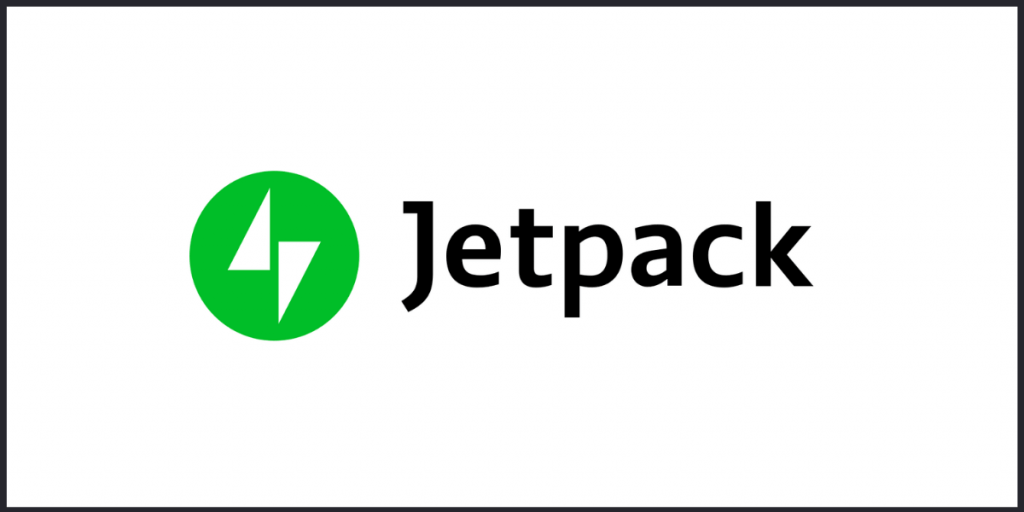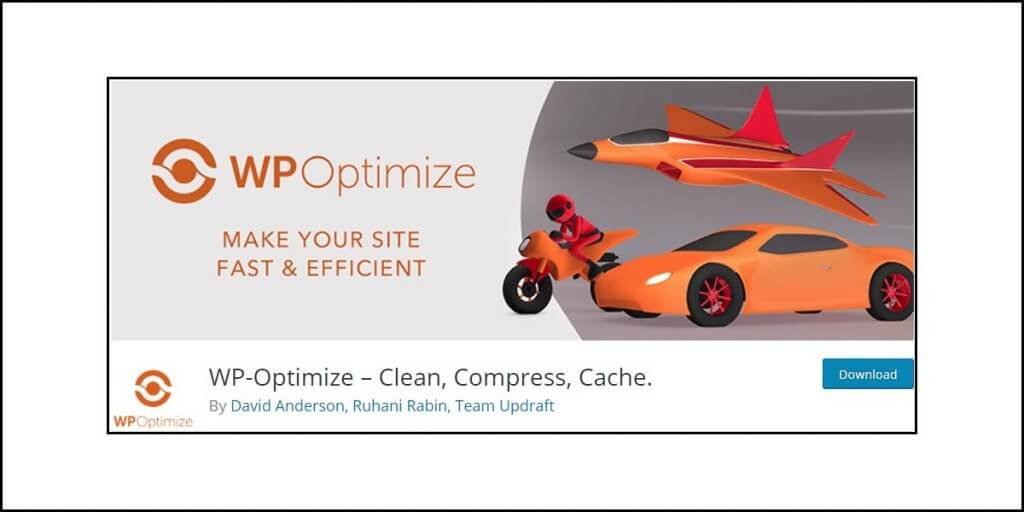Honestly, you do not need this tutorial, at least not in today’s world where every hosting company (shared, cloud, dedicated, VPS, managed WP hosting – whatever you can think of) offers a one-click installation process.
You will be doing this only under the following scenarios:
- Your hosting company does not offer a one-click installation process. This is highly unlikely.
- You want to learn the art of manual installation. That is an acceptable reasoning.
- You want to create database name and password that is easy to remember.
No matter what drives your decision, this tutorial on how to install WordPress manually will tell you all that you need to know.
At the end of this tutorial, you should be able to install WordPress on any hosting server manually (except managed WP hosting where they will not allow you to manually install WordPress).
This tutorial will focus on a shared hosting server where you will have access to cPanel. In case you do not have access to cPanel, you can use FTP to upload WordPress to your server. No matter which hosting provider you are using, you will always have access to phpMyAdmin or a similar interface where you can create a database.
In this example tutorial, I am going to work with the famous cPanel with the only difference being that there is no one-click installation available. That is because there is no Softaculous one-click installation program available.
People, let us begin!
This tutorial will have the following steps:
- Download WordPress
- Upload WordPress to server
- Deflate the zip file
- Move the deflated files to root folder
- Create database
- Install WordPress and log in
These are extremely simple steps and should not take any more than 5 minutes, which is why, WordPress installation was once called the famous 5-minute installation.
Let us go through one step at a time. Just pay attention and by the end of this tutorial, you will feel like a pro.
Step 1: Download WordPress
The first step is to download the installable WordPress files. These files form the core of your WordPress site. So, they need to be on your server.
The download process is simple. You must visit this link, scroll down a little and locate the zipped file.

You will notice that there is a big blue download button and right underneath it is a small link. Is there a difference?
Yes, there is some difference. While both represent the compressed WordPress files, the one that you download by clicking on the blue button will be a zipped file in the format wordpress-5.7.2.zip.
If you click the small link underneath it, you will still download the same WordPress files, but the compression is the tar file format, which works just like zip. It will compress the WordPress files and save it with the extension tar.gz.
If you download using the link, you will get a compressed file in the format wordpress-5.7.2.tar.gz.
You can use any! There is no difference. Both files can be uploaded to your server, and both files can be deflated (extracted). People usually go for the zipped file because they are aware of it and they mostly use it daily.
It is your choice!
I will be using the zipped file.
Once you download the file, you should know the download location. Just cross check that it has downloaded.
The zipped file will have a file size of 16,472 KB while the tar.gz file should have a size of 15,382 KB.
Yes, tar gives better compression, but that hardly matters in this case.
Step 2: Upload WordPress to Server
Okay, this is where you need to start taking cautious steps. You cannot afford to make a mistake.
Fire up your control panel (that is, open it) and locate the File Manager. It will be present no matter which shared hosting provider you are using.
It should look something like this:
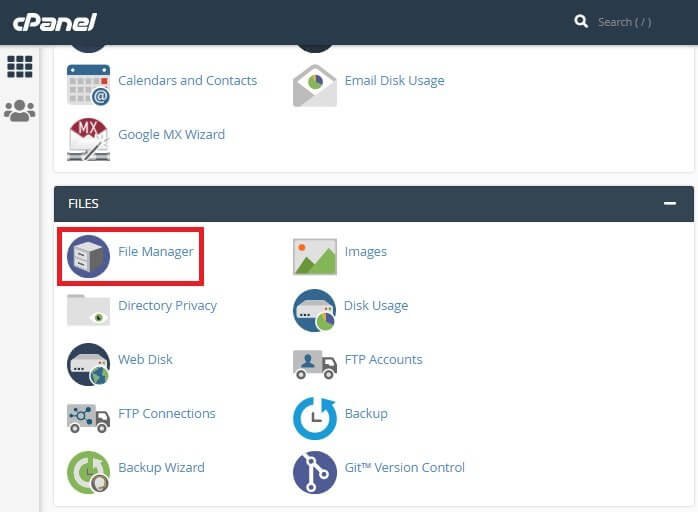
The cPanel screenshot you are seeing here is using the Paper Lantern theme. Your cPanel may look slightly different. But you should find the File Manager under the Files group.
Click on the File Manager to open it. It will open on a new tab by default. This is what you will see:
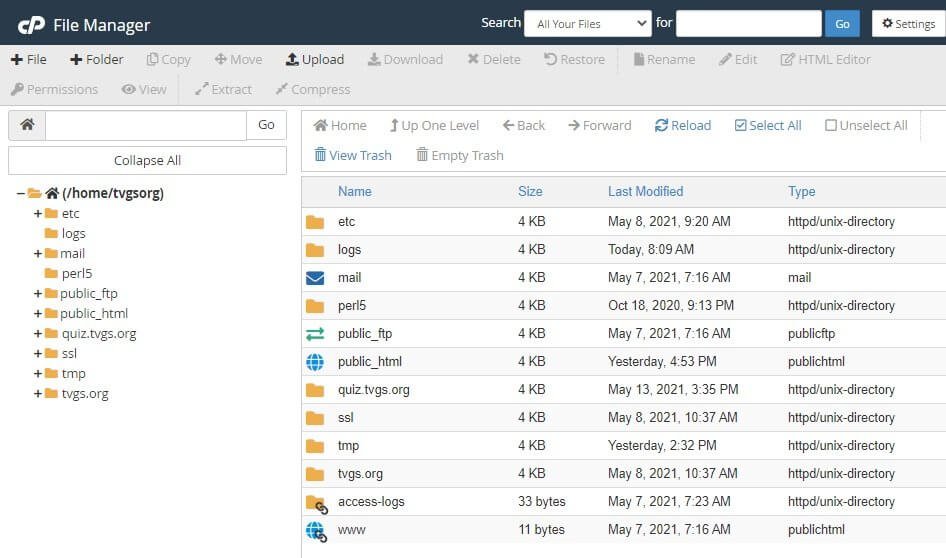
On the left you will see a list of menu items. It will contain a folder called public_html. You can see same menu (folders) on the right along will a couple of extras.
The public_html is the root folder where you need to upload your downloaded compressed WordPress file.
Click on the public_html folder to open it. You may see a few files already present in the folder. No need to delete them. Keep them as is.
This is what you will see:
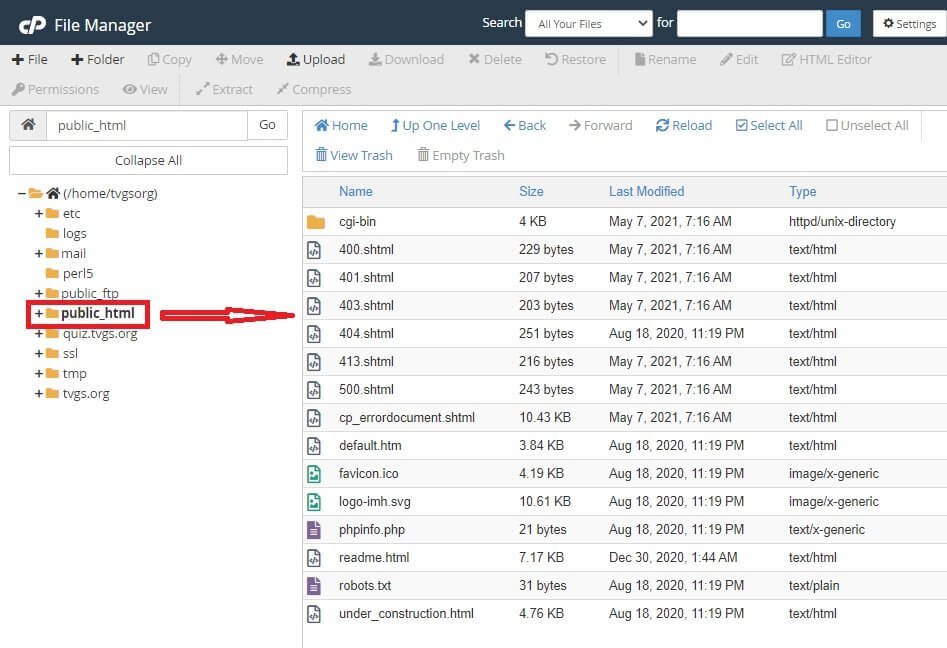
On the top of the File Manager, you can see many more options like File, Folder, Copy, Move, Upload, Download, etc.
See the image below:
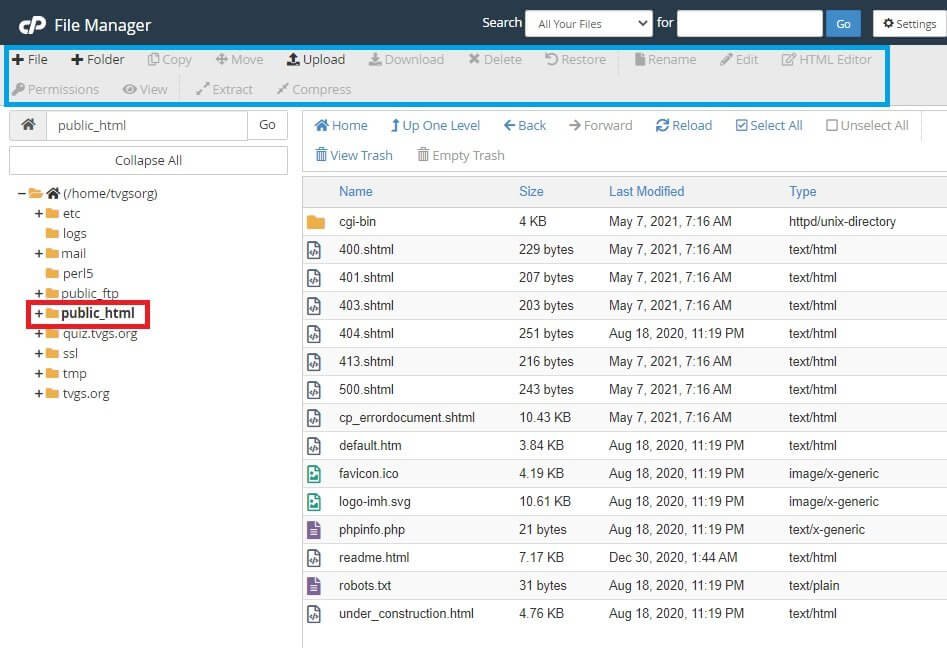
Notice the options highlighted using a blue box on the top. There are diverse options including the Upload option.
Click on the Upload option. The action will open a new tab with a file uploader.

You can decide to drag and drop the downloaded file, or you can click on the Select File button to find and select the compressed file you downloaded from WordPress.org.
Once you select the file, the upload process will finish with a couple of seconds and this is what you will see:

Yes, the upload happens almost instantly. It is fast!
Now, click on the “Go Back to” link you see below the upload status. This will close the tab and take you back to the public_html folder (on the previous tab) where you can see the uploaded file.
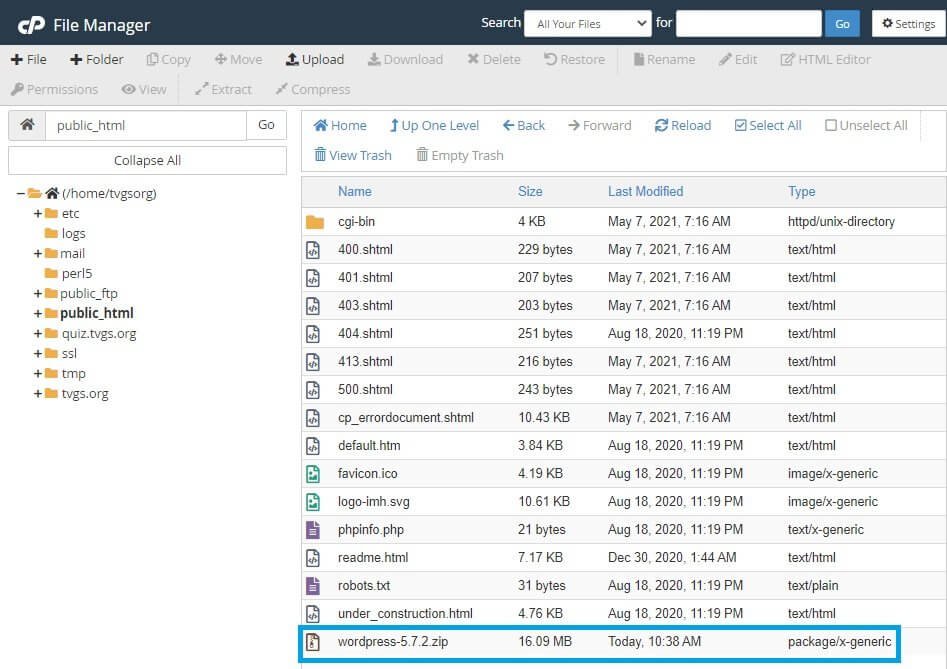
In the image above you can see the zipped WordPress file at the very bottom.
That is all! You have uploaded WordPress to your server.
Step 3: Deflate the Zip File
What you have on you server at this stage is a zipped (compressed file). You must decompress it or deflate it before you can proceed.
Just click on the zipped file to activate some of the greyed-out options on the top.
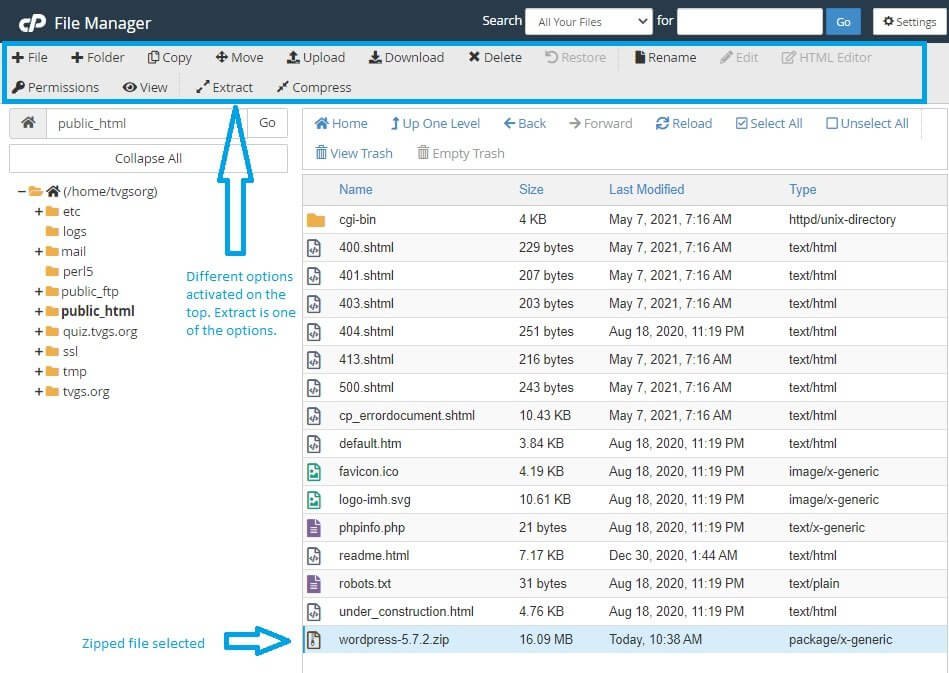
Notice that one of the options activated on the top is ‘Extract.’
Now, click on the Extract link you see on the top (ensure that the zipped file is selected).
Once you click on the Extract link, a small popup will show up. It will ask you to provide the extraction location. By default, public_html should be populated there, and that is precisely where we want the extraction to happen.
So, leave it as is!
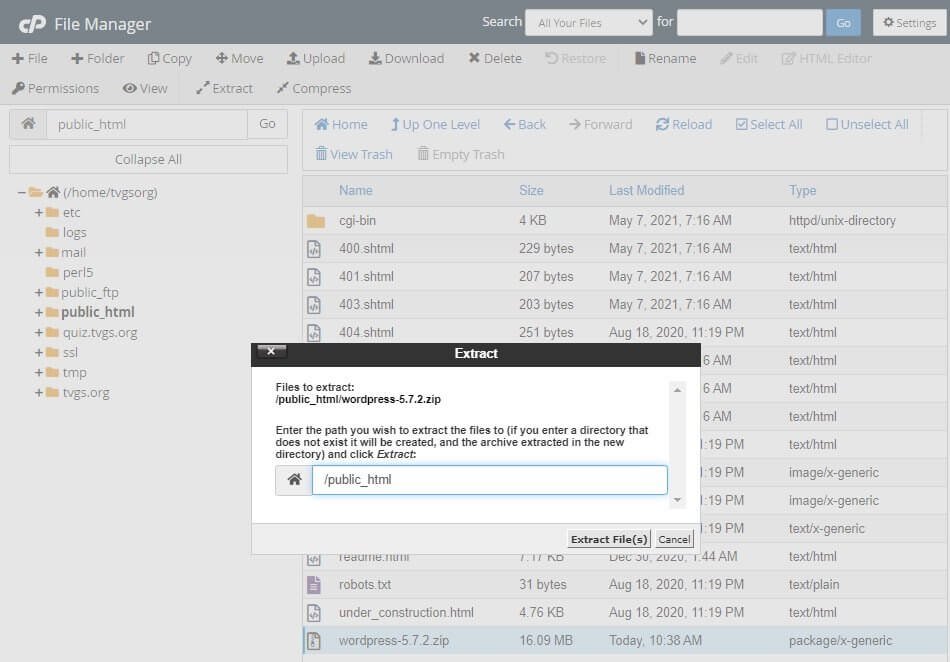
In case you see the field empty, or you see a different location, change it to /public_html. Do not be afraid. Just click on the field and remove whatever is there and then type in /public_html.
Once the extraction path is provided, click on the Extract File(s) button you see at the bottom of that popup.
Now the files should finish extracting within a few seconds. Once the extraction is over, you will see another popup showing Extraction Results. It will show you the steps taken during the extraction process.
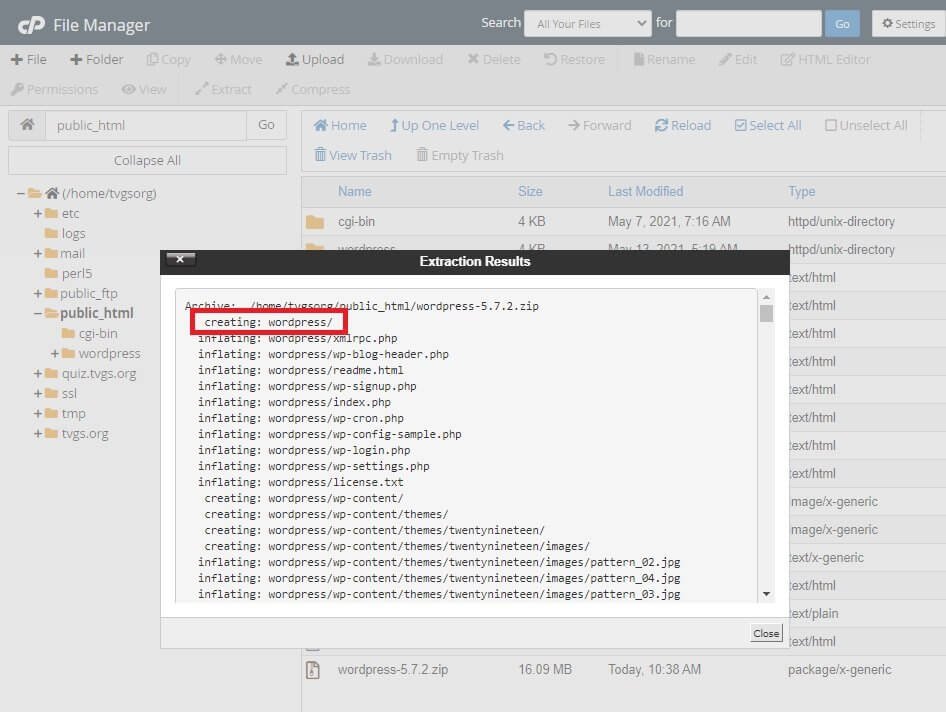
You will notice that it created a folder called WordPress (highlighted using a red box).
Now you can close the popup and see what is there in the public_html folder. You will notice the new folder named WordPress.
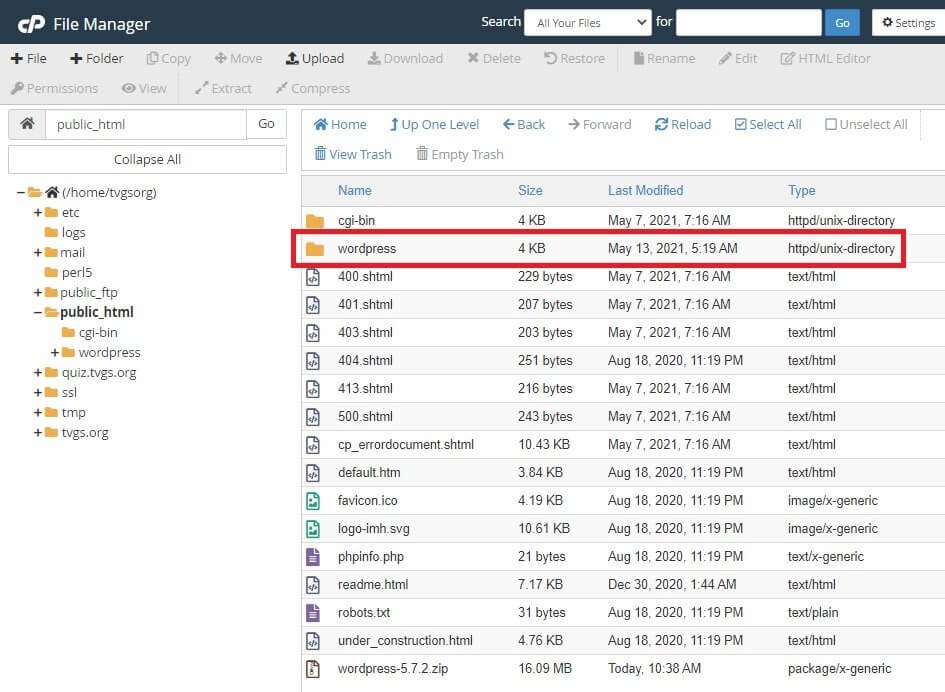
All the WordPress files are now present in that WordPress folder. The files are decompressed.
You need to move all these files in the WordPress folder and put them directly into the public_html folder.
The reason is that if you do not move it to the public_html folder, your website can be accessed only through the URL: https://yourwebsite.com/wordpress/.
So, your website will essentially be present in a subfolder of your root domain. If that is what you want, then fine. But when someone types in https://yourwebsite.com/, this is what people will see:
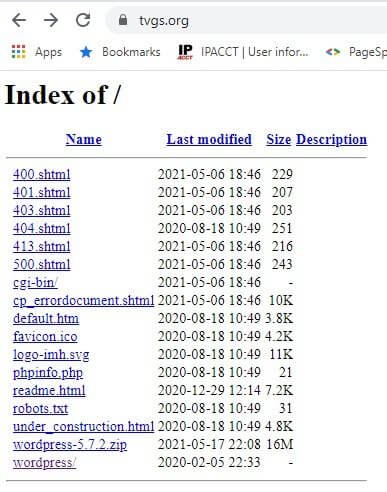
This is not an ideal thing. So, your WordPress installation must be in the root folder, which is none other than the public_html folder. It should not be present inside a folder located in the root folder.
So, it is time to move your WordPress files to the root folder.
Step 4: Move the Deflated Files to Root Folder
At this point, double-click on the WordPress folder and you will enter the folder where you can see all the decompressed WordPress files.
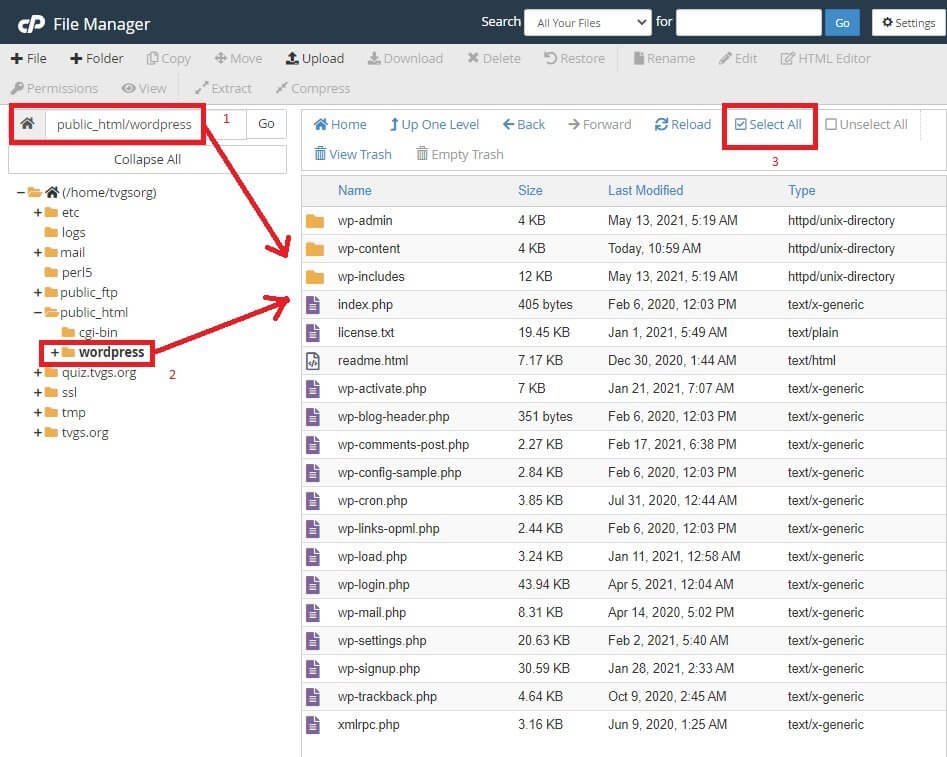
You can either type in the path as highlighted in the box marked 1 and hit the Go button, or you can click on the option marked 2 in the left menu.
Either way, you will enter the WordPress folder where you can see all the WordPress files.
You will also notice that there is a Select All option (marked as 3) on the top.
Click on the Select All link and all the files and folders will be selected.

Once all files and folders are selected, you will notice that the Move option becomes active on the top (highlighted using a red box).
Click on that Move option. This will open a popup and ask for the location where you want to move all the files. By default, you should see the path set to /public_html/wordpress.

You need to change that path to /public_html. So, this is what it should look like:
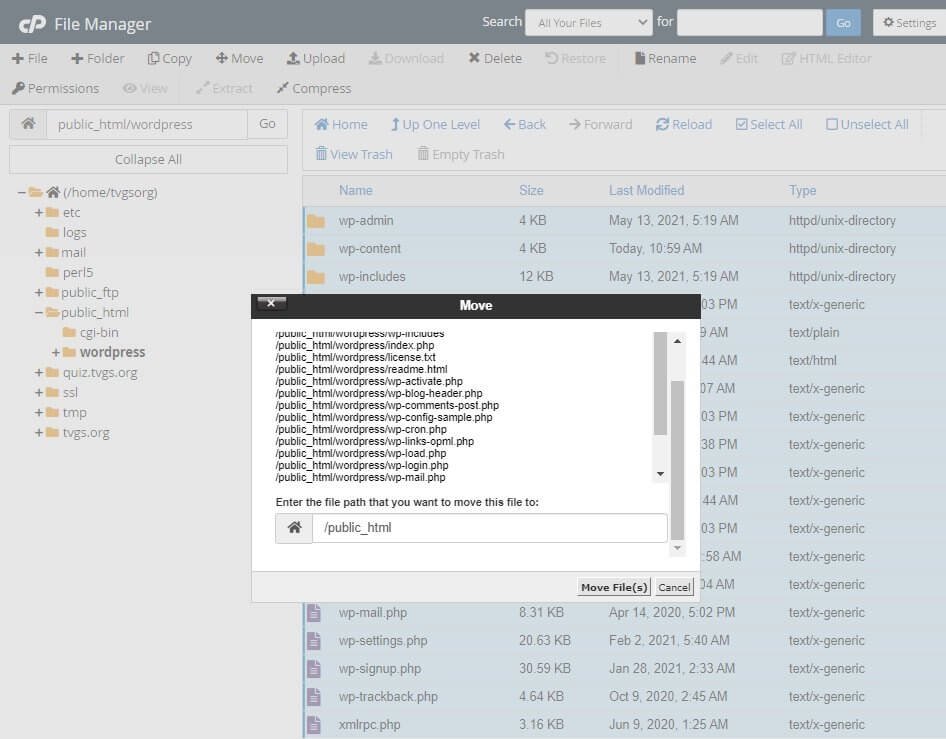
Once you have set the right path, click on the Move File(s) button. The files should now move into the root folder.
Now go back to the public_html folder and you can see your WordPress files there along with the WordPress folder which is no empty.
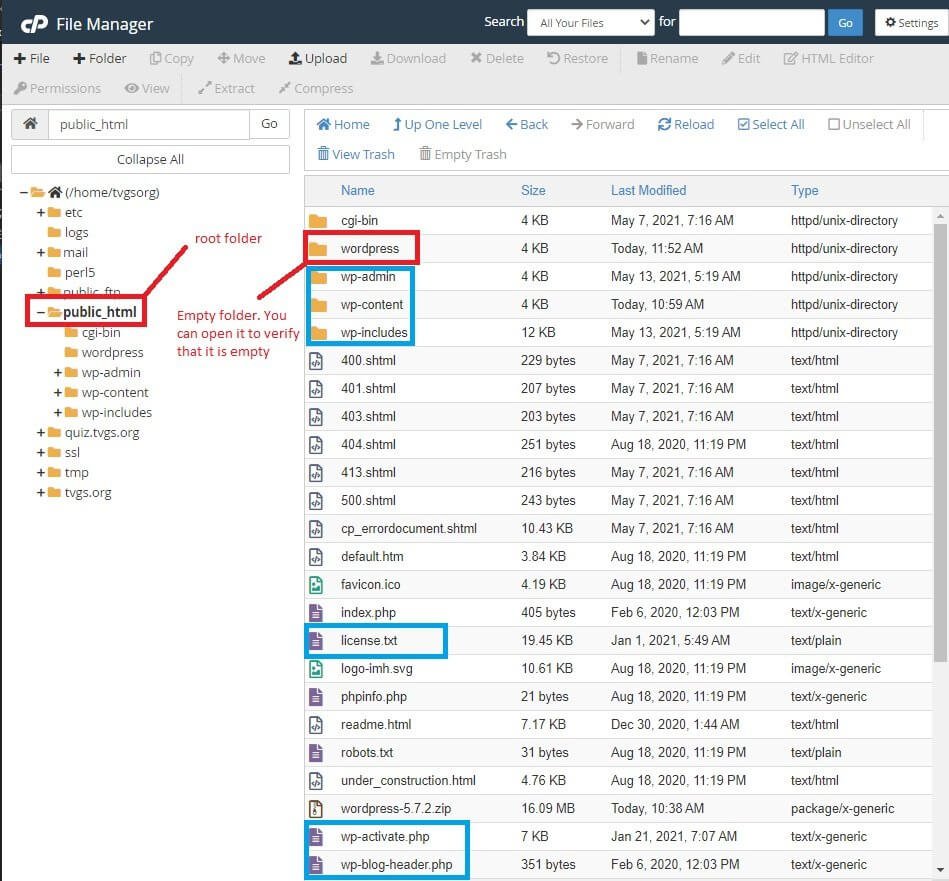
In the image above you can see that the root folder (public_html) is selected. The WordPress folder sits there, but it is empty. The core WordPress files and folder (some of them highlighted using the blue boxes) are present in the root folder.
You will also notice that the zipped file is still present in the root folder.
Go ahead and select the empty WordPress folder and the zipped file and delete them using the Delete option that activates on the top after you select those two.
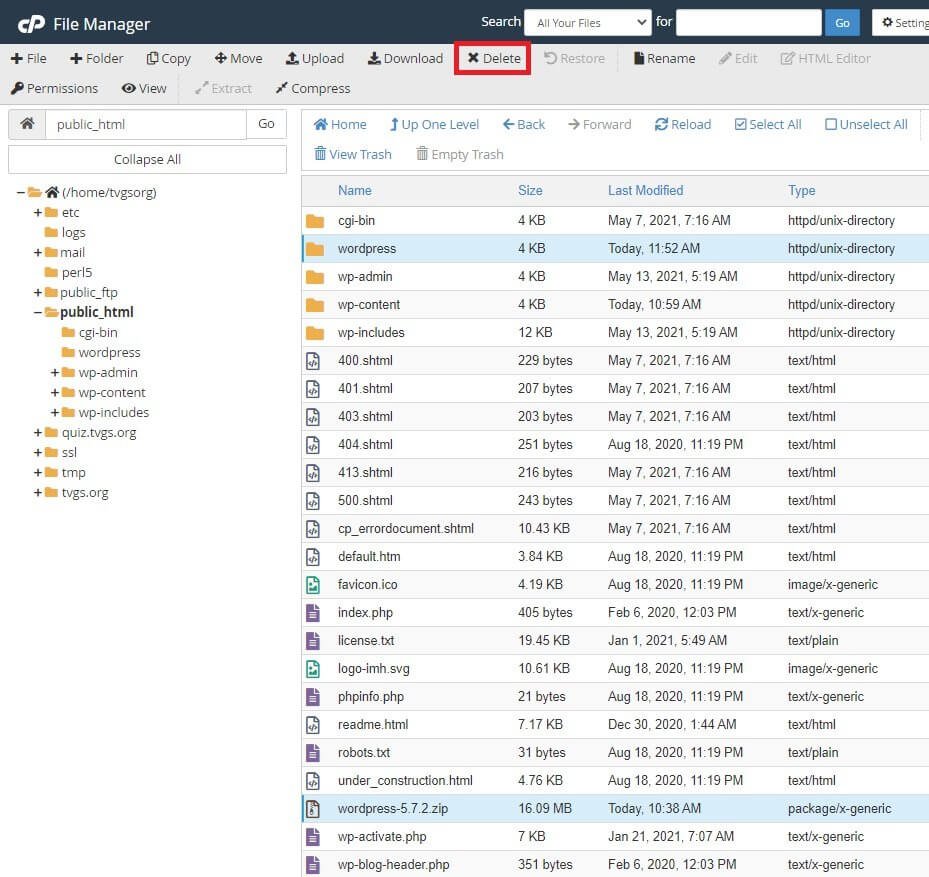
For selecting those two, hold down your CTRL key on the keyboard and click on the WordPress folder and the zipped file. This will activate the Delete option on the top. Click on the Delete option to delete the selected ones.
Once you click the Delete option, a popup will appear where you can select whether you want to send them to the trash folder or want to permanently delete them. If you send them to the trash folder, you can retrieve them later.

You do not need to put them in the trash folder. You do not need them any longer. You can permanently delete them.
Step 5: Create Database
Remember, WordPress cannot work without a database. A database is the backbone of any WordPress site.
So, to install WordPress, you will need a database. You need to create one. Since this is a manual installation, no one is going to magically create a database for you.
It is your task, and you need to accomplish it.
Let us learn database creation. It is simple!
Go back to the tab where you opened your cPanel and locate the Databases segment.
There you can find the MySQL Database Wizard.
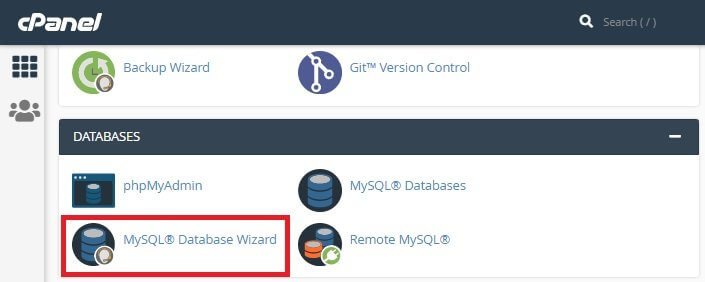
Click on that option to start the database creation process. Clicking on the wizard will show you the screen where you need to enter the database name. It will look like this:
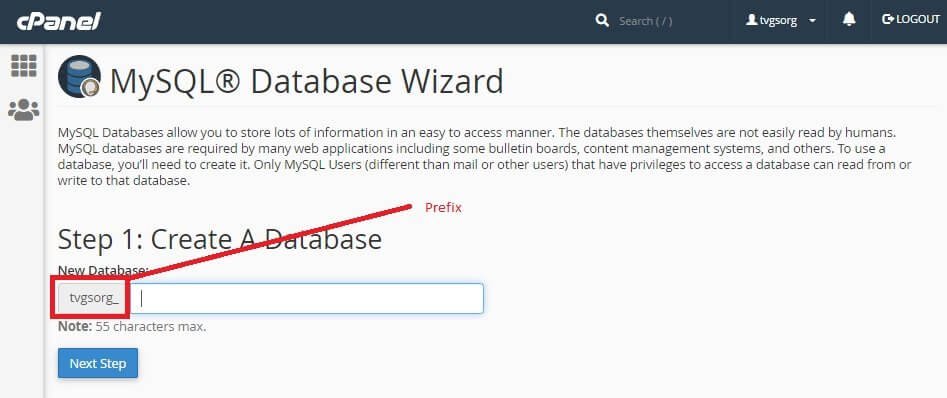
Depending on your web hosting provider, the prefix can be something else. In this case, they are using the domain name. Your web hosting provider can use a random string of numbers and letters. The prefix really does not matter.
What matters is the name you are providing. It is important because if you have multiple WordPress sites on the same hosting server and you need to work with the database of a particular site, you can use that unique name to identify the database.
So, provide a unique name that you can remember.
In this case, I am using tvgsorg_Sankalan.
tvgsorg is the prefix in this case and the name database name is Sankalan (which is my name, and I cannot forget it unless someone or some even erases my memory).
So, the result looks like this:
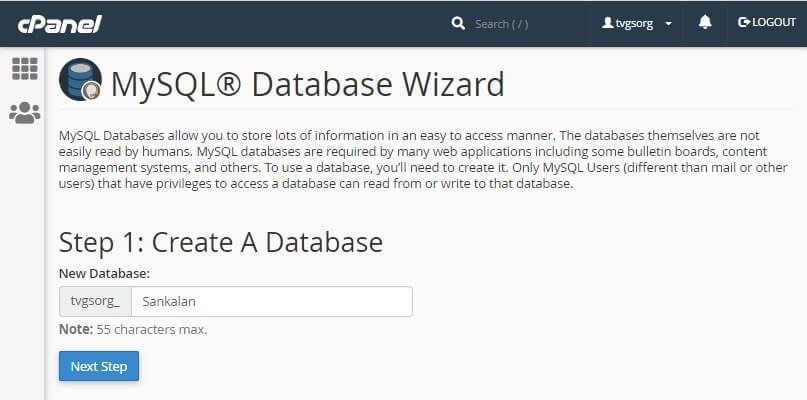
Now, once you provide a unique name (make a note of the name including the prefix somewhere else as you will be needing it shortly), click on the button which reads ‘Next Step.’ This will take you to the next step where you must create a database user and set a password for your database.
You will see this screen:
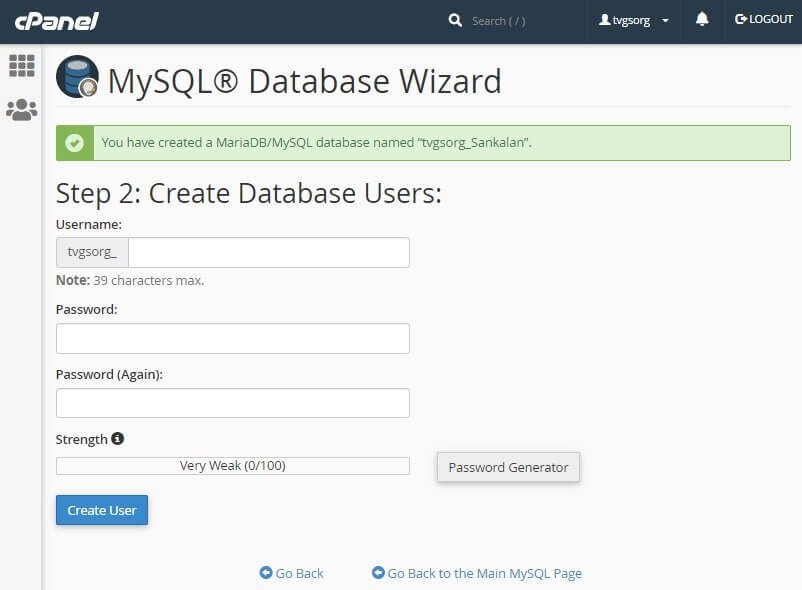
Give a unique admin name. I am using SankAdmin (the first four letters are the first four letters of my name). You can use something else instead of following the same pattern.
Also, you can create a strong password by yourself, or you can use the password generator to create a strong password.
So, after you provide the details, this is what it should look like:
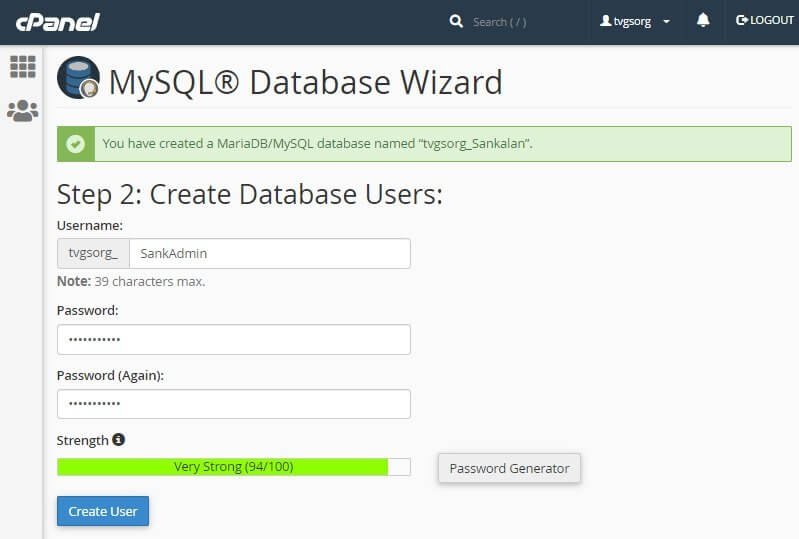
Make sure that the password is “very strong.”
Keep a note of the user and the password. You will need them, too!
Now, click on the Create User button. Once you do that, you will reach the third step where you must add privileges.
Assuming that you are adding yourself as the database manager and you own your website, you should be the admin. So, provide all the privileges.

Just click on the ALL PRIVILEGES on the top and all options will be selected. Now, click on the button which says, “Next Step.”
On the next step you will notice that the new user has been added to the newly created database.
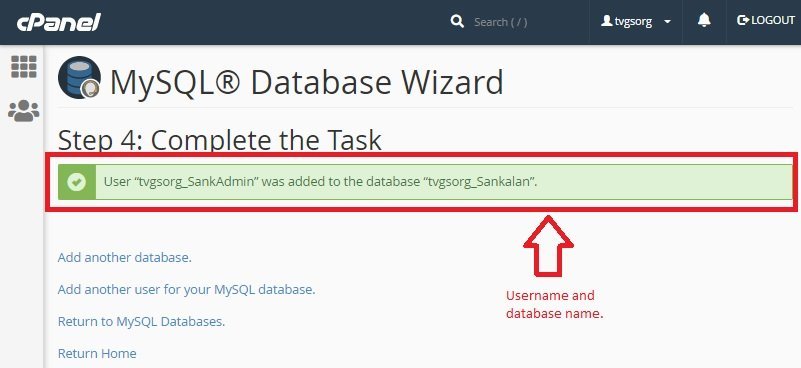
You will also find options for creating new database or adding new users to the newly created database and so no. Not needed!
Hopefully, at this point you have the username, the database name and the password saved. You will need them in the next step.
Step 6: Installing WordPress and Connecting It to the Database
Remember, you moved the WordPress files to the root folder? It means that you can now access WordPress simply by typing in your domain name into the URL bar or the address bar of your web browser.
In this case, the domain name is tvgs.org.
Typing in that domain name into the address bar of the web browser returns this:

Yes, the moment you type in your domain name and hit the enter key on your keyboard, the URL will change to:
Note that it may have https or http. If you have http, you can later install SSL to make it https.
On this page, you get to select the language for your WordPress installation. There are many languages available. English (United States) is the default option.
I will go ahead with the default.
Click on the Continue button and you will see this screen where you will be notified that you need to provide the database name, database username, database password, and database host.

Click on the “Let’s go!” button to proceed.
You will see the screen where you need to provide your database name, database username and database password.
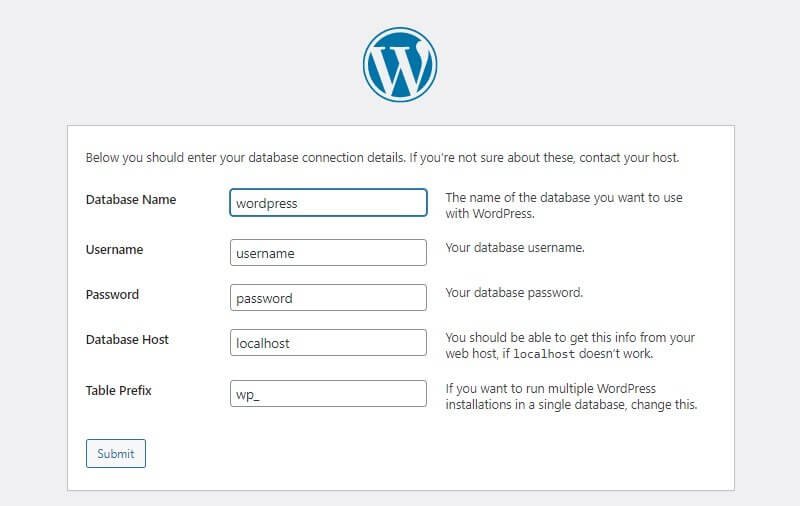
You will see some default values, but you need to change them.
The last option, that is, ‘Table Prefix.’ Do not leave the prefix as “wp_” because that will make it easy for hackers. Put anything else. Something like this:
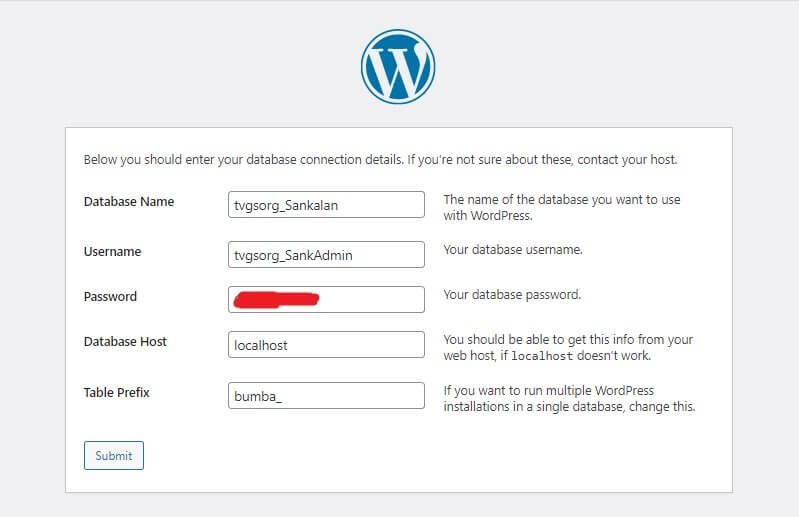
See how I changed the regular “wp_” prefix to “bumba_”? You can add anything you want.
Once you have added the details, click on the Submit button.
If you have entered the details correctly, you will notice this:

Click on “Run the Installation” button to proceed with the installation.
You need to enter the site title, add a username, a password, and an email ID. You can decide whether you want search engines to discover your site or not. This is the screen that you will see:
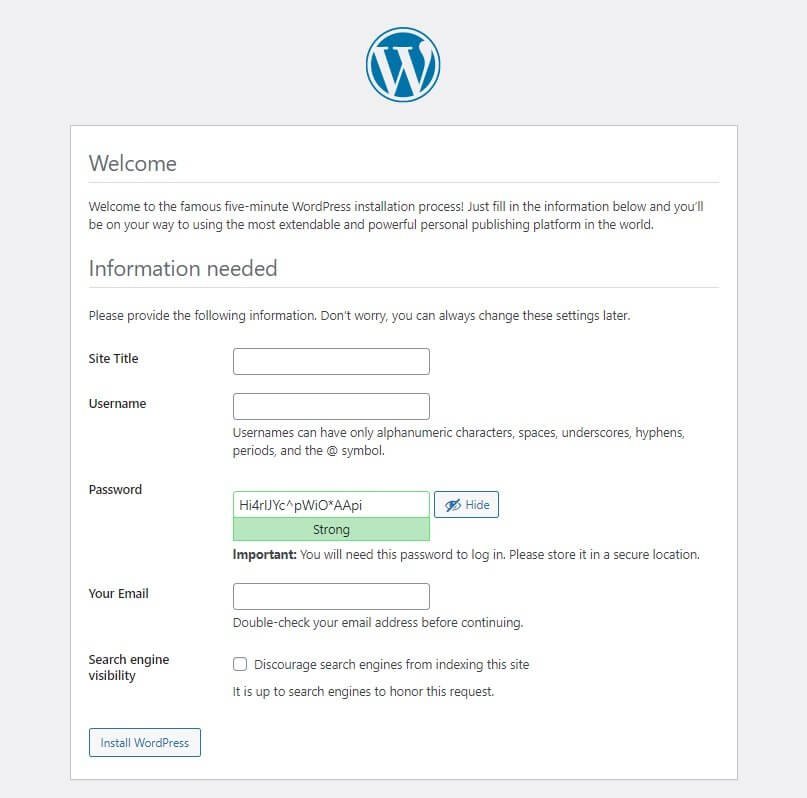
If you want, you can change the password or use the one that is already provided.
Make sure that you are keeping a record of all the information you provide here. This is the information you will need for logging into your website’s dashboard.
If you forget the information, you can retrieve it from the database, but that will be a complex thing to do. So, it is better that you keep a record of all the details you enter here.
Once you provide the information, click on the Install WordPress button at the bottom.
Once the installation is successful, you will see this screen:
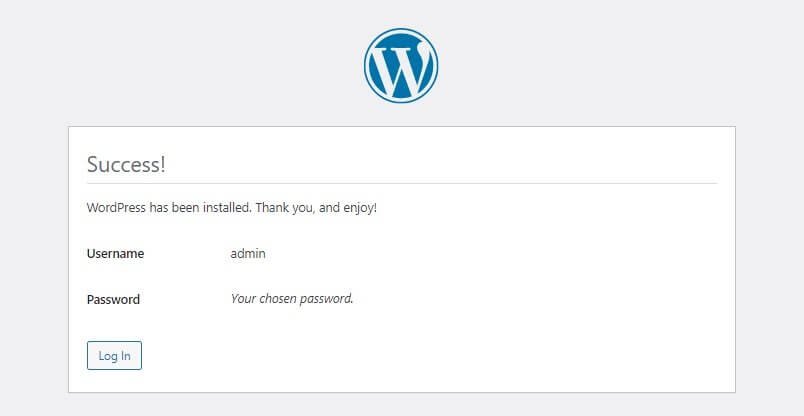
Now, clicking on the Log In button will take you to the login screen for your WordPress website.
This is the login screen you will see:
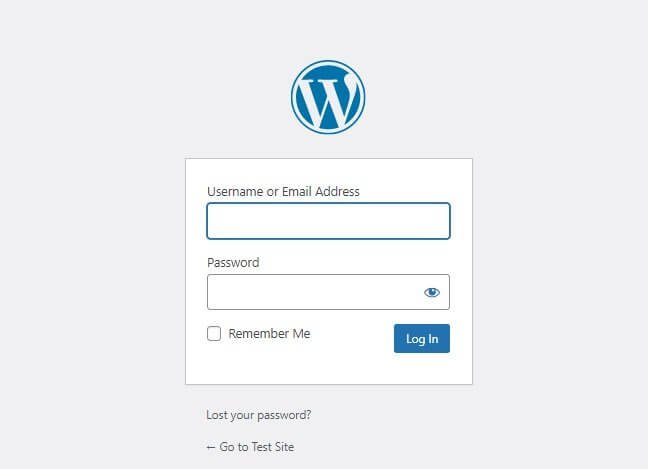
And if you type in the domain name into the browser’s address bar, this is what you will see:
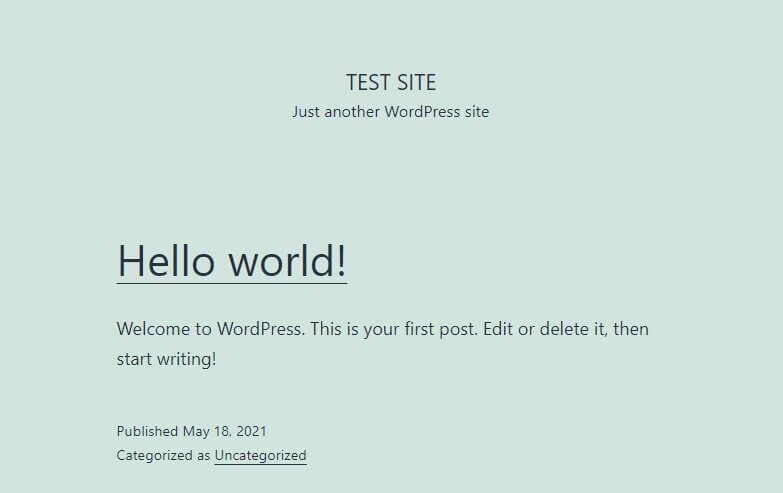
Here you can see the name Test Site because that is what I used. You will see the name that you provide. You will also see the default “Hello word!” post.
Voila! You have successfully installed WordPress.
Feeling like a pro already?
That is great! You know what? You indeed achieved something great. It is the first step towards learning a lot of complex things over the coming years.
Wrapping Up
You do not need to install WordPress manually. Almost every hosting provider will give you one-click installation. But if you do insist on learning manual installation, here is a quick recap:
- You can use either the zip file or the tar.gz file.
- Extract and move the WordPress core files into your root folder (public_html).
- Create a database by providing a database name, database user, and database password. Keep a note.
- Provide all privileges.
- Open your domain (URL) in browser, set language, and establish database connection.
- Provide website details and continue with installation.
The process involves only six steps. When done right, it will not take more than 5 minutes. In fact, you can have a WordPress installation up and running in less than 3 minutes.
Just be meticulous!
